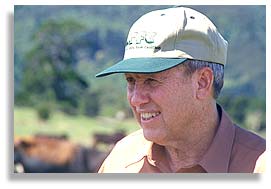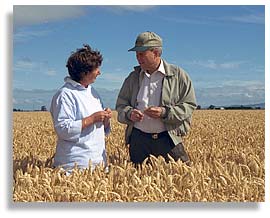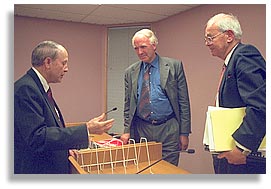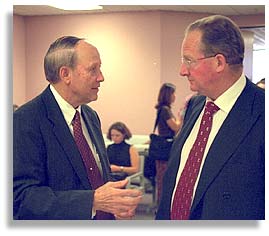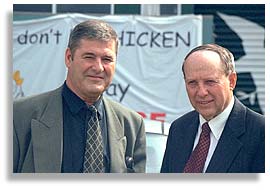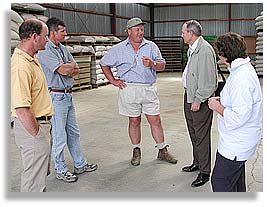|
Facing The World Today
GMO's: farm policy, patent laws, contamination, trade Interview with Bill Christison
Bill Christison is president of the U.S. National Family Farm Coalition and president of the Missouri Rural Crisis Center. This interview is part of an extended series of articles and interviews gathered by In Motion Magazine in the context of the 2000-2001 hearings of New Zealand's Royal Commission on Genetic Modification. In Motion Magazine travelled around New Zealand with Missouri Rural Crisis Center and National Family Farm Coalition president Bill Christison visiting farmers and community leaders and listening to their views about genetically modified organisms. Currently there are no commercial GE crops in New Zealand. After hearing the recommendations of the commission the New Zealand government will make a decision on whether or not GE crops will be allowed in New Zealand. This interview was conducted February 21, 2001 by Nic Paget-Clarke. Also see:
In Motion Magazine: Why did you travel half way around the world to attend this hearing on genetic engineering. Why is it so important? Bill Christison: I went to New Zealand to appear before the Royal Commission that was appointed by the government to figure out whether or not genetic engineering should be allowed into the country. I have done a considerable amount of work for a number of years around GMO’s. I have traveled to many parts of the world and I truly believe that this is one of the largest issues that is facing the people of the world today. It’s a problem that is brought on by a handful of genetic engineering corporations with no concern for the general public and the consumers that buy the products that we as family farmers produce. Farmers are being asked to produce below the cost of production. Because of this problem, and it is an agricultural policy problem and a common complaint of family farmers around the world, farmers are easily pushed into producing GMO’s. Last year, some 55 percent of the U.S. soy bean crop planted was GMO. 19% of the corn planted was genetically-modified Bt corn, though that’s down from the previous year of about 33%. Nearly 90 percent of the GMO’s that are produced around the world are being produced in the United States. My concern is that once this technology is released into the environment, it’s impossible to undo the negative effects. GMO problems for family farmers in the United States circulate around several key issues. One of these issues is that the policies that have brought us extremely low prices for our production are made worse by genetic engineering. The economics of genetic engineering means lower prices for family farmers. The bottom line is that GMO’s cost more and yield less. To begin with farmers were duped into planting GMO’s by slick advertisements in the trade journals. The GMO’s promise higher yields, lower costs, and better products with more ease of operation. But really, little or none of this is true. Genetically engineered seeds are very expensive. On our farm we are seed savers, Because we are seed savers, we have a constant supply of high quality seed that we use to plant our acreage each year. We obtain this seed by buying a small amount of conventional seeds of the best varieties that we can find. We grow them out, handle them in a special way, then clean them. The result is that we have had the ability to produce fine seed for six dollars and fifty-one cents an acre . If we were planting GMO seeds during the same time frame the cost would have been 42 dollars an acre. This is a substantial difference when you are producing below the cost of production. A second problem is that with the GMO seed I would not have the right to use those seeds to replant the following year because of the patent laws. The patent laws prevent me from doing that. There are risks and liabilities because the GMO corporations have a legal right to file suit against me for patent law infringement. The net results of patent law infringement can be heavy fines. A third problem with planting GE seeds is that it has been proven many times that genetically engineered seeds simply yield less. The Benbrook studies show after 8200 tests a 4.6 bushel-acre less yield.
The fifth problem is contamination. The biggest concern with corn contamination is the leaking of Bt from Bt corn into the ground. This upsets the structure of the soil. We don’t know what the result of that will be, but it’s recognized by scientists as a problem. We also have a situation where soy beans that have been sprayed by glyphosate (Roundup) over a period of time develop a fungus called fuserian on their roots. Whenever fuserian grows on the roots of a soy bean plant, that plant will be more susceptible to a disease that is becoming very prevalent in the Midwest -- Sudden Death Syndrome. This disease covered a great deal of the Midwest this past year. The other part of contamination has to do with pollen. A 40 acre field of corn has the ability, according to the GE corporations to contaminate as much as 140 acres around that field. They have a buffer zone that they say you should observe of about 1/8 of a mile around a GE crop. But the real truth is that the amount of contamination that comes from the pollen on to an adjoining field is dictated by the velocity of the wind, the humidity, and insect and animal activities. There are reported cases where bees have carried the pollen as much as six miles. As a result of pollen contamination, irate neighbors file lawsuits because their crop is no longer GMO free. The sixth problem relates to exports. We are finding this year that the overall market in corn is down dramatically. This a direct result of the lack of exports and countries not wanting to accept genetically engineered crops -- especially Starlink. There has been a great deal of contamination with Starlink corn being commingled with other corn. Both Bt Corn and non-Bt corn. According to economists in our country, the effect of genetically engineered corn is that the overall world price of corn is about 30 cents a bushel less than it would be if we had not had these kinds of problems. 30 cents a bushel is not a lot of money unless you are talking about the possible profit margin on your corn. Many farmers are not even breaking even on their corn and to lose an additional 30 cents is very significant. This points out that we need to supply what the customer wants and our government and our GE corporations should stop trying to shove products down our export customers throats which they do not want to swallow. Starlink has brought a rash of law suits and that is because of the loss that farmers are suffering due to Starlink. The situation is that the Aventis genetic engineering corporation has agreed to reimburse farmers because although Starlink did not have clearance for human consumption it found its way into food products that humans eat. Not only in this country, but in other parts of the world. The attorneys general in a number of states have demanded that Aventis corporation reimburse the farmers for the losses that they are incurring. But the farmers are suffering much more loss than what they are actually going to get compensated for. There is no insurance company that I’m aware of any where in the world that will insure a genetic engineering company because the risks are unknown. There are many scientists around the world that have done studies that show that there is a risk of cancer. The whole idea of genetic engineering is a technology that is looking for a necessity. Some sort of necessity to justify itself. To this point genetic engineering has done very little except produce a plant that will withstand the chemical Roundup. I think the reason that we have genetic engineering is that Monsanto was losing the Roundup patent. The patent was expiring and they wanted to try to maintain their market share of Roundup. Genetic engineering was a way for them to do that. Lastly, I want to mention the USDA’s piece in this whole process. USDA owns, in part, the terminator technology patent. The terminator technology would produce a sterile seed that farmers could not replant even if they wanted to and USDA is working on this issue. They are spending taxpayer money on this issue in association with Delta Fineland Corporation. The most massive anti-trust suit ever filed In Motion Magazine: Please tell me about the anti-trust suit being filed against the GE companies. Bill Christison: One of the steps we have taken to correct the situation is to get the genetic engineering companies to accept the liability and the risk associated with the damage that they have done attempting to flood the world with GMO’s. Their rush to market. The failure of performance of their products. And the anti-trust issues that have created a near monopoly. In the early spring of 1999, the National Family Farm Coalition met with the Foundation for Economic Trends, which is headed up by Jeremy Rifkin an extremely knowledgeable person who has written many books on genetic engineering and has spoken at a very large number of seminars and trainings around the world. On December 14, 1999, the Foundation and the Coalition initiated what the Financial Times of London said was possibly the most massive anti-trust suit ever filed. The suit was filed against Monsanto and all co-conspirators charging the issue of anti-trust; charging the issue of failure of performance; and charging the issue of the rush to market without adequate testing of products.
At this point, it appears that this suit will be heard in the Spring of 2002. We are very hopeful that this is going to reveal the true position of the genetic engineering companies and cause them to accept responsibility for the trouble they have brought to not only the United States, but to the world. We have 12 very high profile law groups working on this case. They have a great deal of expertise in these areas. We are in the period of discovery. In Motion Magazine: What is the significance of the Royal Commission? Bill Christison: The significance of the seating of this Royal Commission and all the testimony that they have received is that this is a very appropriate process. New Zealand is the first country in the world to go through this sort of a process. The significance is that the people that were on the list of speakers have had their say. They have brought a great deal more information into the process than would have been there otherwise. There is significance in the process in that everyone had to make a rational attempt to substantiate what they say. This is unlike what has happened around the world. There have been 5,000 patents and licenses for field trials issued in the United States which should never have been allowed short of proving first that all of this technology is safe. I believe that the members of the commission themselves were chosen in a very good way. They had broad knowledge. They had a grasp of the issues and they allowed a good process to go forward. I would also like to say that I was invited to New Zealand by Greenpeace. I can’t say enough about how effective and knowledgeable the people from Greenpeace are. They have really brought to the forefront this world issue of genetic engineering. Greenpeace in New Zealand has spent a great deal of time on these issues and they have done a great job. In Motion Magazine: Please describe your role at the hearing. Bill Christison: I was one of the few farmers that came from around the world to speak on the issues of genetic engineering. I submitted my witness brief in the fall of 2000. In Auckland, I had an allotment of time to present spoken testimony. My testimony was different from my witness brief because it was of a different nature, but basically hit the same points. I was asked questions by all four members of the commission. That took considerable time and was in considerable detail. I was cross-examined by the genetic engineering corporations’ bank of lawyers and also by the council for the commission. All in all I was asked questions by eight different individuals and was able to make the points that I thought needed to be made. I want to say that at the hearing I heard the testimony of world class scientists and other people speaking about the effects of genetic engineering. In Motion Magazine: Please tell me about the farmers you visited in New Zealand. Bill Christison: While in New Zealand I had some time to spend talking with numerous farmers and farm groups about farming conditions. New Zealand is truly a very beautiful country and has a very diverse agriculture. The land is well cared for and it’s a very rich fertile country for the most part. The farming takes place primarily on the flat land and the mountains are used for some grazing purposes. The farms are not huge by our comparison at all, they are more or less family farms. The farmers that we met with were well-equipped. In most cases that I observed there was full employment for both the wife and the husband on the farm with very little outside help hired. They were very knowledgeable about issues around the world and they hold an opinion about genetic engineering. We visited with dairy farmers and we visited with some fairly large farmers that are producing organics. We also talked with the leadership of the Federated Farmers which is the organization which most farmers in New Zealand belong to. After talking with these farmers, it seems to me that they are looking at genetic engineering with a careful and measured approach. They have a good comprehension about the intricacies and what constitutes a GMO and how the whole process works.
The membership have questions about genetic engineering. But the leadership seem to be committed to the idea that genetic engineering would be a good thing. Now this is not to a man, but overall. This is after talking with a fairly large number of farmers from organic farmers, to farmers doing dairy, pork producers, and farmers in leadership positions. Some have a fear of not having access to this genetic engineering technology, that they might become viewed as a backward world. At the same time, others have a fear of genetic engineering and they only want to go so far into that field. There are a number of farmers that we talked with that think the future of New Zealand would be much better served to go the organic route and to keep genetic engineering out of the country and therefore be a world export leader of non-GMO products. I came away with the opinion that these farmers were more than happy to live by the results that the commission lays down and the government implements. Because of its unique spot on the earth, I believe the interest of the New Zealand people would be best served if they could be a non-GMO nation and have the opportunity to provide for other parts of the world seed crops that would be certified non-GMO. I believe that some people don’t quite understand the ramifications that the genetic engineering corporations have planned for the countries that accept the technology. I think that the people, the farmers, in New Zealand have an entrepreneurial spirit that would not fare well becoming a sort of serf property beholding to the genetic engineering corporations. After looking at New Zealand across the country in several locations, and talking with a great number of New Zealand farmers that produce a wide variety of goods and product it seems a certainty to me that they are in a very enviable position from the standpoint of there are no GMO’s in their country to speak of at the present time. They are going through the appropriate process. It is refreshing for farmers around the whole world to see this kind of leadership. In Motion Magazine: What about trade issues, from the perspective of New Zealand farmers? Bill Christison: I believe that if New Zealand was to accept genetic engineering there would be negative trade consequences for New Zealand farmers. It’s a certainty that the world does not want GMO and I believe it’s a certainty that what the future holds is less demand for GMO’s. It’s a question of economics to the average farmer. It comes down to issues of trade and all the unanswered questions surrounding GMO’s. It is a certainty that the major food processors and food sellers around the world are increasingly taking a step back from GMO’s. Not that they are necessarily against GMO’s, but they don’t want the consumers to shy away from buying their products. After looking and thinking of the whole process here I think that if New Zealand allows GMO’s into their country it will cause an economic ripple through their economy that will not be good and could shut down their export sales. New Zealand exports a great deal of milk and meat and those products would be some of the first products that would suffer a negative consequence. Substantial equivalence theory In Motion Magazine: Please compare the process of how GE was introduced in the U.S. to the process in New Zealand. Bill Christison: In the U.S., genetic engineering has been going on, to a significant degree, for 25 even 30 years. Also, we have had field trials for quite a long time. We have had wholesale distribution with a lot of pressure being put on farmers to plant GMO’s. There has been little or no government regulation of GMO’s in the United States. I have a document which shows that when the elder Bush was president, the Monsanto’s of the world came and met with him and asked for regulation because they felt they needed to have some regulation. What they were looking for was the opportunity to write the kind of regulation that they wanted, regulations which flowed from a process they called the Substantial Equivalence Theory. That means they said that the genetically engineered products were the substantial equivalent of conventional seed and therefore needed no regulation. As a result, the FDA, the EPA and the USDA have not interfered in this process until recently with the advent of the disaster with Starlink corn. As a result, the United States is flooded with GMO’s and we are reaping a bitter harvest. We have a great deal less exports now than what we used to have and we have extremely low prices. The United States is probably the worst example of making a decision about the appropriateness of genetic engineering. On the other hand, New Zealand is at the opposite end of the spectrum. In New Zealand, there have been very little, if any, GMO’s let loose in the environment. You have to commend the government of New Zealand for the approach they’ve taken. In Motion Magazine: What is the GMO situation in Europe and South America? Bill Christison: I’ve spent a great deal of time in Europe and some time in South America. I have traveled through most of the European countries. Some of them several times. I can tell you that the Europeans are very much against genetic engineering. I think this is a result of the attitude of the people in Europe. The people in Europe are much more knowledgeable about their environment. They are much more favorable to family farm agriculture. At the present time, there is a high degree of organic production and that organic production is increasing in most areas. In Motion Magazine: What’s a high degree? Bill Christison: I think it’s 40 to 60 percent in some countries. The situation that I found in South America is that there is a great deal of GE in Argentina. Brazil has a stated policy that they want to be GMO free and there are some provinces that are nearly GMO free but a small degree of GE has been smuggled in. On a recent visit to France, I talked with the people who are in charge of imports into France. They told me they sent buyers to the U.S. asking for non-GMO soy beans. The government in the U.S. said, “There’s nothing the matter with GMO’s. We’ve got lots of them and we want to sell them to you.” But that was not what they come to buy. They were not hooked up to find the product that they wanted to buy, so they just hopped on a plane and went to South America. Brazil was able to guarantee them the kind of products that they want. What they want is non-GMO. When in South America, I visited, far up into the interior of Brazil, a large cooperative that produced certified non-GMO soy beans. They test every load that comes in. The beans that we saw at that cooperative were the same beans that the French had come to the United States to buy. As a family farmer, I had lost a prospective sale to the people in South America who picked that sale up. They will continue to do that because the buyers want availability of what they want to buy. It’s high time that the U.S. make the positive decision that they need to supply to the consumer the products that they want to buy and stop trying to shove down the importers throats a product that they don’t want to have anything to do with. And certainly don’t want to buy. Shared international food security In Motion Magazine: Recently you spoke at the United Nations. Why were you there?
As a result, we are losing something like 500 farmers a week in the United States. I think it’s important to note that a very small percentage of our population farms. We have something like 280 million people in the U.S. and a total of 1.9 million farmers. Less than 13 hundredths of one percent of the population of the U.S. is producing 83% of the food and fiber produced in this country. A farmer is defined as anyone that produces as much as a thousand dollars worth of goods or product. As a result of all of these situations, along with a great deal of other negatives like the mergers and acquisitions , the extremely cheap prices, the globalization issues, and the continuing greater influence of multinational corporations, the National Family Farm Coalition and other affiliated organizations have put together a comprehensive farm bill proposal. In that proposal are some new ideas. We are beginning the process with a return to the non-recourse loan. We are looking to build a farmer-owned reserve. We want to implement anti-trust law when it is appropriate. We want a packers and stockyard law to be implemented to level the playing field for the producers of the food and fiber, and for the consumers in the U.S. We hope to be able to do this through a shared international security food reserve where all countries pay some of the costs of providing for emergencies and disaster relief. This would provide a place for the world's family farmers to put some of their surplus production. At the present time, there is one and one half times the supply of food that there is demand for food. This doesn't mean that there are not nearly a billion people that go to bed hungry every night, it means that the IMF and the World Bank and other institutions of like intention are making loans then draining the income out of people. The food that needs to be used in Third World countries is exported in order to pay back the loans that have been made earlier, loans that were in many cases not handled appropriately. International shared supply management program The other thing that we are proposing is talking with the countries around the world that have the ability to export. That is a limited number of countries. Some six or eight countries around the world have any ability to export. What I think would be a good idea, and I’m talking for all of our organizations now, is for these countries to get together and make an agreement to work on a international shared supply management program. This would be entirely appropriate and would help bring a more stable price to the producers of food around the world. We can do this I think fairly easily. This policy would run counter to what the food processors and the multi-national corporations that are causing our problems would like to see happen. They want to see full production and they want to see the taxpayers pay a subsidy to farmers in order to lower the price of their cost on raw materials. That would result in a situation where they can make a huge profit. Many of them make a 50% profit and they would be able to sell the product at a low enough cost that they can move a great amount of their processed foods. Because of the tax-payer subsidies, people would be able to pay. What we are looking at is to totally eliminate the subsidy system except for a very small degree. Maybe as little as two billion of the 32 billion dollars that was spent in subsidies this past year in the U.S. Subsidies only make a place for the multinational corporations to work and it is a flawed process. Trading your country into prosperity is a mirage I believe it is very important that exporting nations come together and go through this process to facilitate a fair and equitable distribution of export opportunity. In the U.S. we have a situation where 80 % of our production is used domestically, and 20% is exported. In New Zealand, for example, those numbers are reversed. This means that there has to be some give and take to allow the New Zealand farmer to buy into this theory and to make it work. We need this dialogue together because there really isn’t that much export opportunity to begin with. We have had GATTs and NAFTAs, and other trade schemes, but the comparative figures supplied by USDA show that in 1975 the U.S. was exporting 1.9 billion bushel of corn and in the year 2000 the figure remained substantially the same. All of this trading your country into prosperity is a mirage. The figures for all the major commodities are very much the same. There is some fluctuation but very little fluctuation. The real problem is that the price has continued to decline to where the exporting country’s farmers are getting about half of the net income that they were getting 25 years ago. This is a major point that has to be reckoned with before we can get farmers a reasonable parity price for their produce and we can change the tide of less farmers and in fact have more farmers on the land. I want to also add that I believe a fair price for the producers would be the greatest conservation policy that we could ever develop. The farmers in the U.S. at the present time are more or less mining their soil because they have to have the maximum production that they can possibly get. The farmers that are producing most of the food and fiber are farming very large acreages and we are depleting our natural resources. Also, we are polluting far more than it is necessary that we pollute. With a new policy where farmers are making a decent return, I believe that we could much better serve the needs of Third World countries. The people in those countries would have a much better economic base because this process would facilitate the farm bill that we are trying to implement and raise the price of corn around the world. The world’s prices are set on the Chicago Board of Trade and our objective at this time is to raise the price of corn to about $3.29. This would allow the farmers around the world to automatically jump up. It would not be just the U.S. that would benefit from this policy. It would be the world’s farmers that would benefit. A Missouri farmer speaks before the U.N.
The four major stakeholders were the farmers of the world, industry, labor, and indigenous people. Eighty percent of the people that made statements spoke very favorably to the policy that we were trying to implement. I was impressed by the response of the indigenous people who were there from around the world speaking on the issues that were important to them and promoting social and economic justice for indigenous peoples. Of course, the business and industry end of this thing was negative to us but the farmers spokespeople from around the world addressed exactly what we were advocating. After the major stakeholder hearings, we entered into a different realm and that is when I had the opportunity to be an official delegate on the U.S. delegation at the United Nations addressing these same issues. In that capacity I was able to speak with each of the members. There were nine or ten of us altogether, and we had internal discussions each morning. I was very impressed by the attitude of the delegation as a whole. This was a different venue than the legislative approach in Congress and we were trying to broaden our base, not only to bring some understanding to people around the world, but also to get some information that was factual to our own delegation. It was a process I was very happy to be able to participate in, and I think we could see some results from that in the future. Also see:
|
||||||||||||||||||||||||||||||||||||||||||||||||||||||||||||||||||||||||||||||||||||||||||||||||||||
| Published in In Motion Magazine May 31, 2001. |
||||||||||||||||||||||||||||||||||||||||||||||||||||||||||||||||||||||||||||||||||||||||||||||||||||
If you have any thoughts on this or would like to contribute to an ongoing discussion in the  What is New? || Affirmative Action || Art Changes || Autonomy: Chiapas - California || Community Images || Education Rights || E-mail, Opinions and Discussion || En español || Essays from Ireland || Global Eyes || Healthcare || Human Rights/Civil Rights || Piri Thomas || Photo of the Week || QA: Interviews || Region || Rural America || Search || Donate || To be notified of new articles || Survey || In Motion Magazine's Store || In Motion Magazine Staff || In Unity Book of Photos || Links Around The World || OneWorld / US || NPC Productions Copyright © 1995-2011 NPC Productions as a compilation. All Rights Reserved. |
||||||||||||||||||||||||||||||||||||||||||||||||||||||||||||||||||||||||||||||||||||||||||||||||||||


